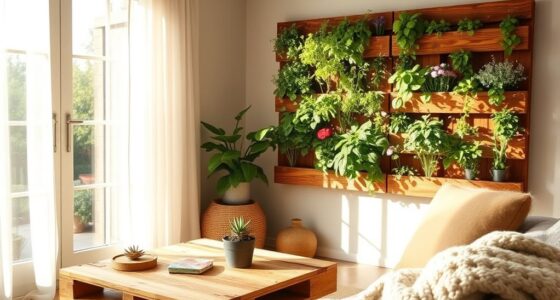Embracing minimalism means simplifying your life by owning fewer possessions, which helps you focus on what truly matters. It creates clarity, reduces stress, and frees up time for more meaningful experiences. When you prioritize quality over quantity and let go of excess belongings, you live more intentionally and sustainably. This journey can lead to greater peace and happiness. If you’re curious about how living with less can transform your everyday life, there’s more to discover below.
Key Takeaways
- Owning fewer possessions reduces clutter, creating a calmer environment that enhances mental clarity and emotional well-being.
- Minimalism shifts focus to meaningful experiences and relationships, enriching life beyond material possessions.
- Simplifying belongings decreases maintenance time, freeing up energy for personal growth and enjoyable activities.
- Embracing less promotes sustainable living by reducing consumption and environmental impact.
- Living with less fosters intentional choices, aligning daily habits with core values and long-term fulfillment.

Have you ever wondered how simplifying your life can bring more clarity and peace? Embracing minimalism isn’t just about owning fewer possessions; it’s a way to create space for what truly matters. When you choose to adopt a minimalist mindset, you start by focusing on sustainable living. This means making mindful decisions about what you bring into your home, opting for quality over quantity, and considering the environmental impact of your choices. Living sustainably isn’t just good for the planet—it also encourages you to be more intentional with your resources, reducing waste and excess clutter. As you progress, you’ll find that decluttering techniques become essential tools in your journey. These techniques help you evaluate your belongings and decide what to keep, donate, or discard. The goal isn’t to get rid of everything but to retain only what serves a purpose or brings you joy.
Simplify your life with mindful choices, sustainable living, and decluttering to focus on what truly matters and bring peace.
To begin, set aside time regularly to declutter your space. Tackle one area at a time—your closet, kitchen, or workspace—and ask yourself if each item aligns with your current needs and values. If it doesn’t, let it go. This process clears out unnecessary possessions that weigh you down physically and mentally. As you remove excess, you create a cleaner, more organized environment that fosters calm and focus. It’s easier to maintain a sense of peace when your surroundings aren’t cluttered with items that no longer serve you. Incorporating the best vacuums for dust removal in 2024 can help maintain a clean environment with minimal effort, supporting your decluttering goals.
Sustainable living and decluttering techniques go hand-in-hand because they reinforce a mindful approach to consumption. When you own less, you naturally buy less, which reduces your ecological footprint. Minimalism isn’t about deprivation but about making conscious choices—investing in versatile, durable items instead of fleeting trends. This mindset encourages you to value quality over quantity, which not only benefits the environment but also simplifies your life. With fewer possessions, you spend less time cleaning, organizing, and maintaining things. Instead, you can invest that time in activities that enrich your life, like hobbies, relationships, or self-care.
Ultimately, embracing minimalism through mindful living and decluttering allows you to focus on what matters most. You gain clarity, reduce stress, and find more joy in everyday moments. It’s a lifestyle that promotes sustainability and mindfulness, helping you live intentionally. As you continue on this path, you’ll discover that owning less truly means living more—more freedom, more peace, and more connection to your true values.
Frequently Asked Questions
How Do I Start Decluttering My Home Effectively?
Start by setting a timer for 15-minute decluttering sessions to stay focused. Use simple decluttering tactics like sorting items into keep, donate, or discard piles. Invest in smart storage solutions to organize what you keep, making your space feel more open. Tackle one area at a time, such as a drawer or closet, and be honest about what you truly need. Consistency is key to effective decluttering.
What Are Some Common Challenges Faced When Adopting Minimalism?
You might find overcoming attachment to possessions tricky, especially when memories are tied to them. Managing social expectations can also feel intimidating, as friends and family may not understand your minimalist journey. To navigate these challenges, focus on your values and set clear boundaries. Remember, embracing minimalism is about living intentionally, not perfection. With patience and self-compassion, you’ll find it easier to let go and enjoy a more fulfilling, clutter-free life.
Can Minimalism Improve Mental Health and Well-Being?
Yes, minimalism can boost your mental health and well-being. By simplifying your environment, you create space for mindfulness practices, helping you stay present and reduce stress. Owning less also strengthens emotional resilience, making it easier to handle life’s ups and downs. When you declutter your mind and surroundings, you feel more focused, peaceful, and in control, leading to a healthier, more balanced life.
How Does Minimalism Impact Financial Stability and Saving?
Getting your financial house in order, you’ll find minimalism boosts your financial stability and savings growth. By practicing financial discipline and avoiding unnecessary purchases, you prevent money from slipping through your fingers. Owning less means fewer expenses and more control, so you can prioritize saving for the future. It’s like killing two birds with one stone—reducing clutter and building a healthier financial cushion simultaneously.
Are There Specific Minimalism Styles Suited for Small Spaces?
Yes, tiny homes and Scandinavian minimalism are perfect styles for small spaces. Tiny homes maximize every inch with smart storage and simple layouts, making your space feel open and functional. Scandinavian minimalism emphasizes clean lines, neutral colors, and clutter-free environments, which help small areas feel larger and more calming. Both styles focus on essentials, so you can enjoy a stylish, cozy space without feeling cramped or overwhelmed.
Conclusion
By embracing minimalism, you free yourself like a bird soaring through open skies, feeling lighter and more alive. When you own less, you create space for what truly matters—meaningful moments, genuine connections, and personal growth. It’s not about deprivation, but about making room for joy to flourish. So, take that first step today; your life will transform, revealing a clarity and peace that’s as invigorating as a clear blue sky after a storm.









